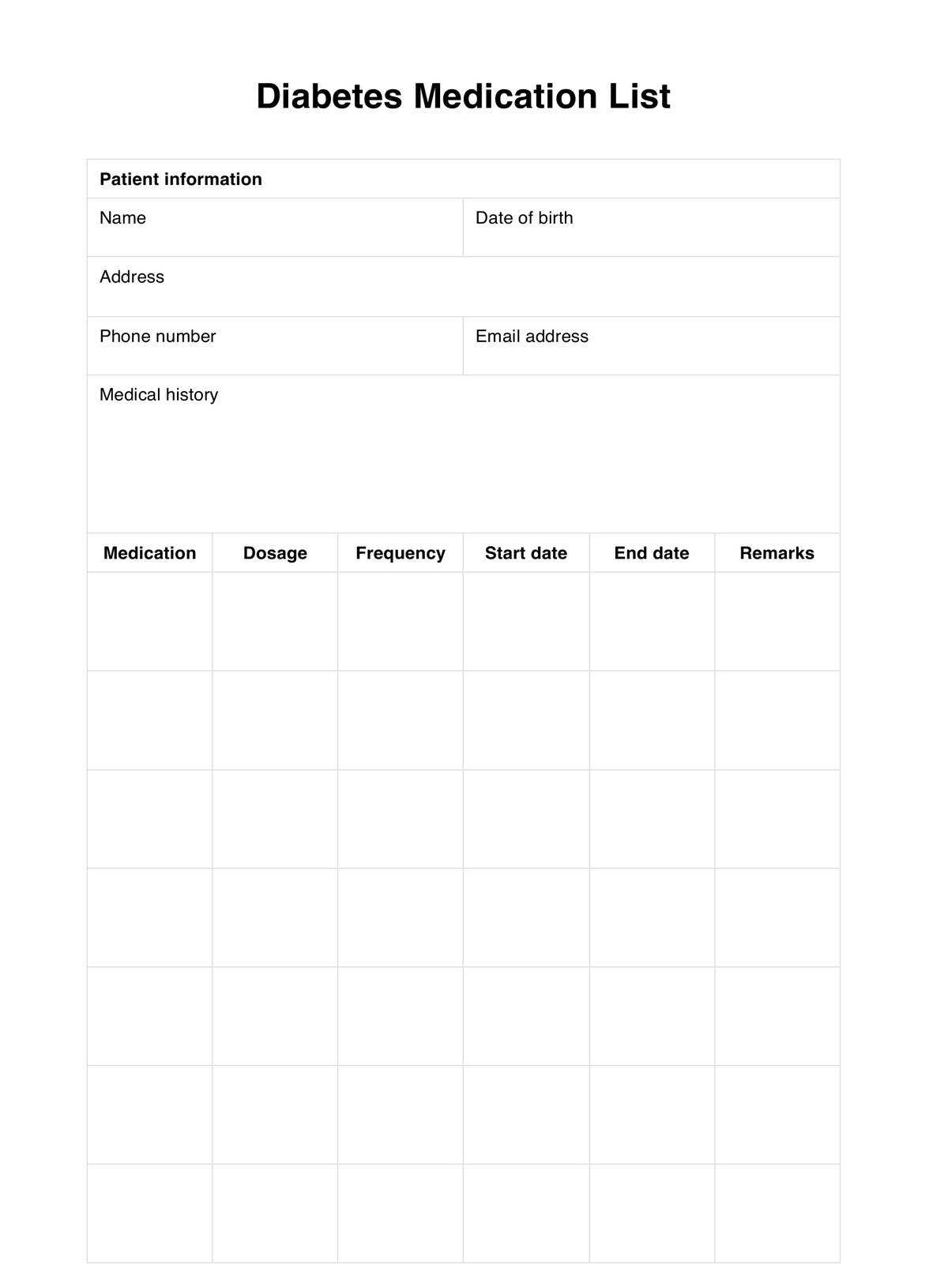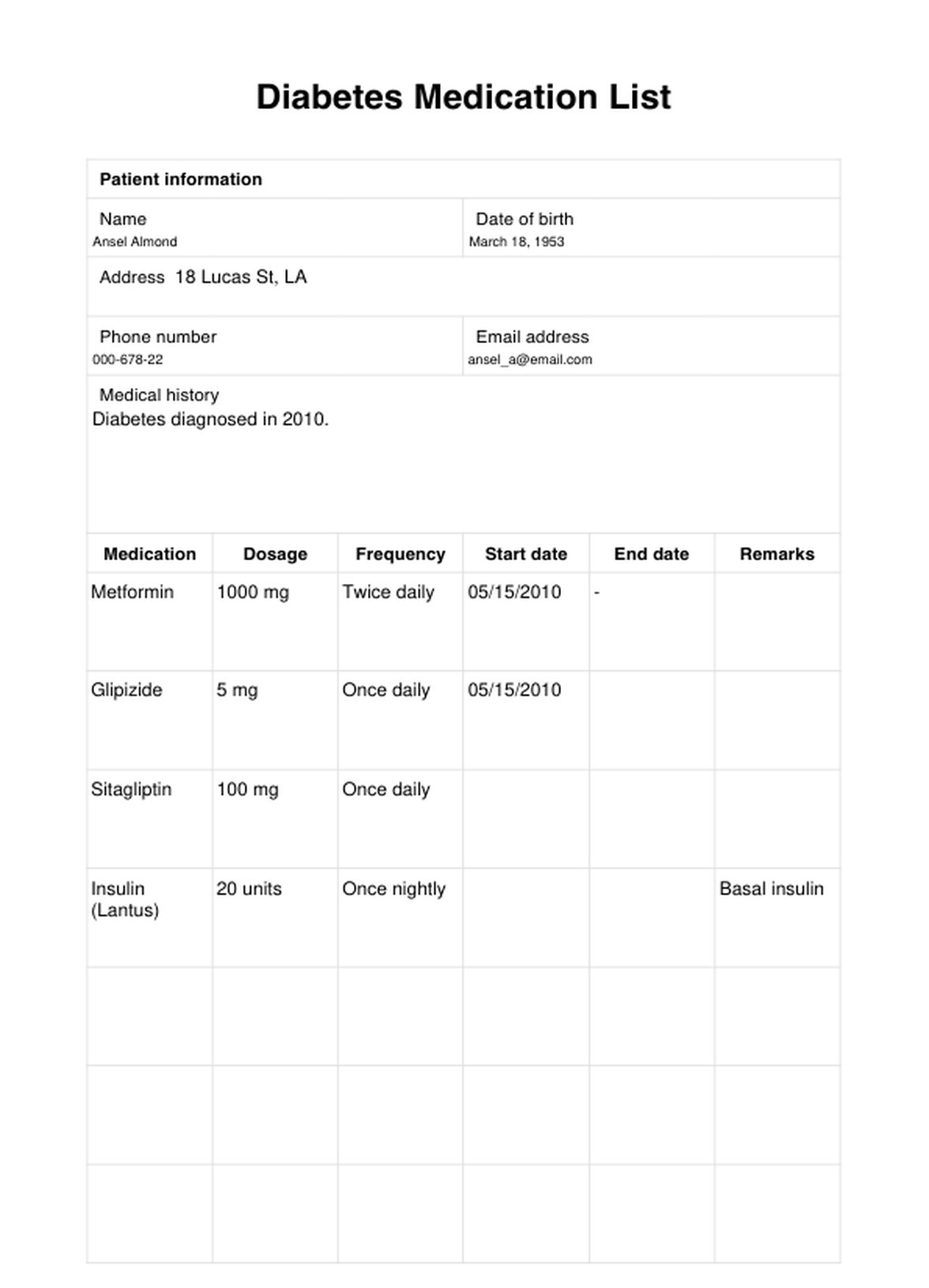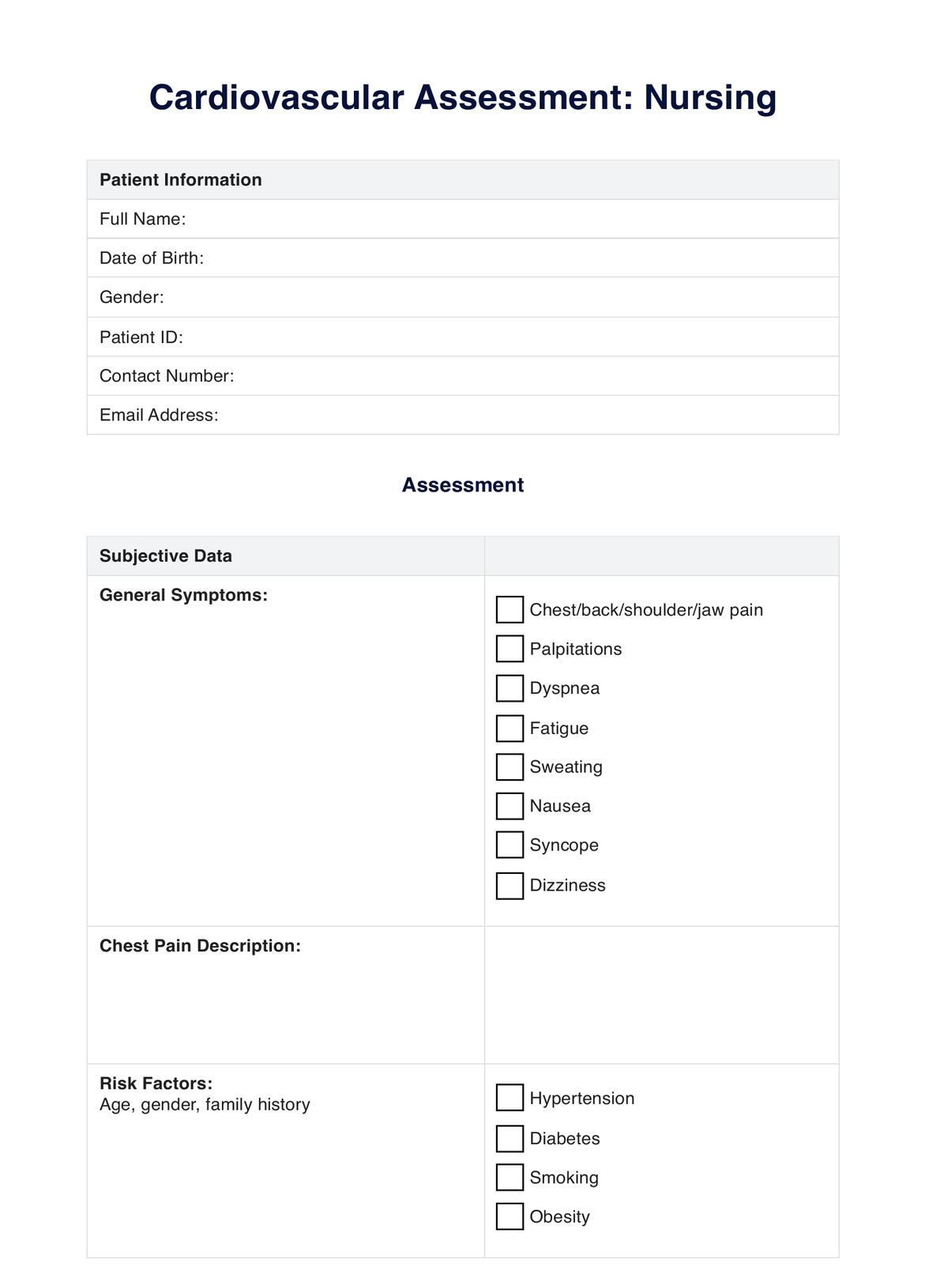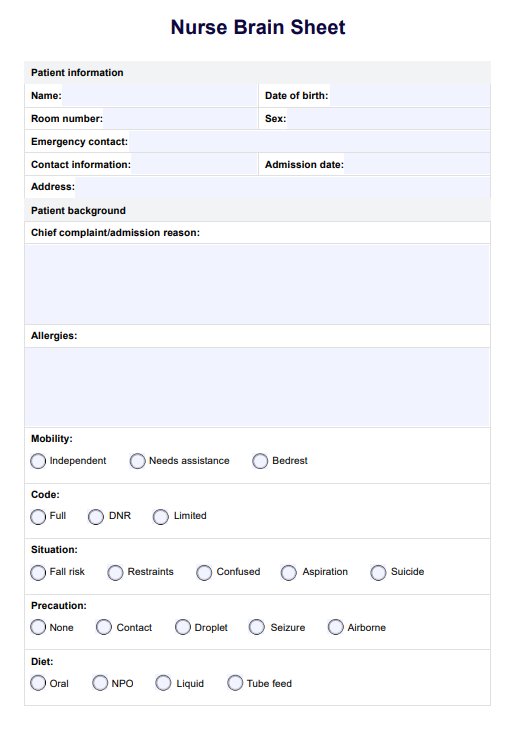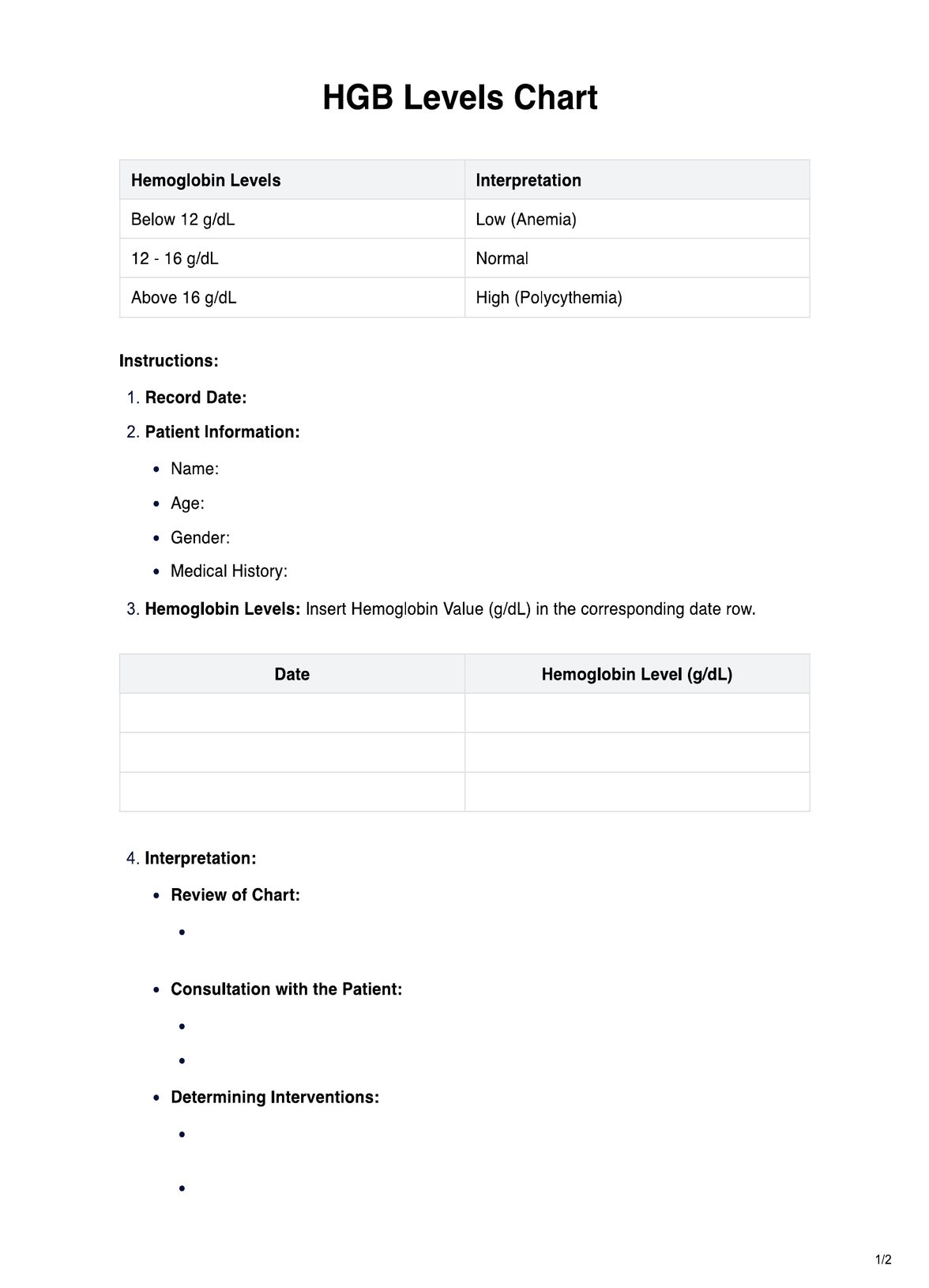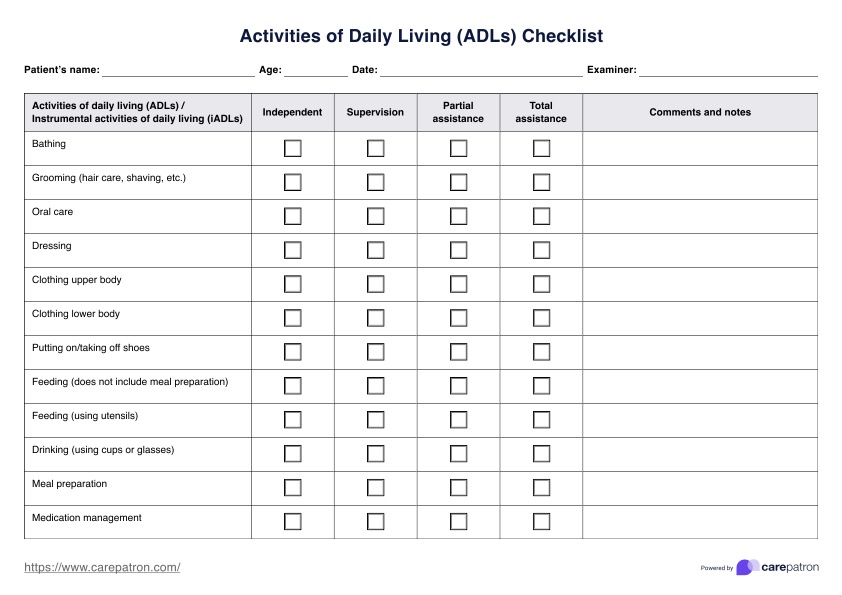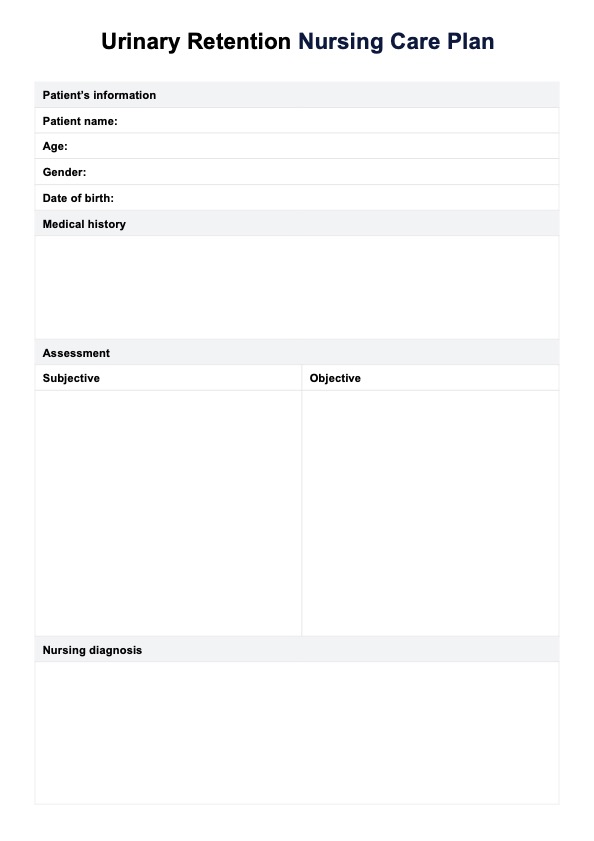Diabetes Medications List
Help patients stay on top of their diabetes with a free Diabetes Medications List. Download the free template and sample here.


Understanding diabetes
Diabetes is a chronic health condition that affects your body's ability to control blood sugar levels. It's categorized into three main types: Type 1, 2, and gestational diabetes.
Type 1 diabetes is an autoimmune condition where the body fails to produce insulin, a hormone that regulates blood glucose levels. Type 2 diabetes, which is the most common type, occurs when the body doesn't use insulin properly, leading to high blood sugar levels.
Meanwhile, gestational diabetes is a temporary condition that occurs during pregnancy and typically resolves after delivery (Centers for Disease Control and Prevention, n.d.). If left unmanaged, high blood sugar can lead to serious health implications such as heart failure and chronic kidney disease.
Therefore, effective blood glucose management, including oral medications, is crucial in treating diabetes.
Diabetes Medications List Template
Diabetes Medications List Example
Diabetes causes and risk factors
While the exact cause of diabetes is unknown, several risk factors are associated with developing the condition. Here are several of them in detail:
- Family history: A family member with diabetes increases the risk of developing the condition. In fact, according to Annis, Caulder, Cook, and Duquette (2005), the odds of having diabetes were almost 15 times higher for those with three or more diabetic relatives compared with adults with no family history.
- Sedentary lifestyle: Lack of physical activity and leading a sedentary lifestyle can increase the chances of developing Type 2 diabetes (Hamilton et al., 2014).
- Unhealthy diet: Consuming high amounts of sugar, saturated fats, and processed foods can lead to obesity and increase the risk of Type 2 diabetes, according to Sami et al. (2017).
- Age: As people age, their risk of developing diabetes increases, especially after age 45 (Annis, Caulder, Cook, and Duquette, 2005).
- Ethnicity: Certain ethnicities like Asian, African American, Native American, and Hispanic have a higher predisposition to diabetes. (Annis, Caulder, Cook, and Duquette, 2005).
Types of medications for diabetes
People with diabetes may require different medications to manage their blood sugar levels effectively. Here are some of the common types of diabetes medications used:
- Insulin: This hormone is essential for regulating blood glucose levels, and people with Type 1 diabetes always need insulin injections or an insulin pump.
- Oral medications: These are taken in pill form and help lower blood sugar levels by increasing insulin production, reducing glucose absorption in the intestines, or decreasing glucose production in the liver.
- GLP-1 receptor agonists: These medications stimulate the pancreas to produce more insulin and slow digestion, preventing a sharp rise in blood sugar after meals.
- SGLT2 inhibitors: These drugs prevent the kidneys from reabsorbing glucose, causing the body to excrete excess glucose through urine.
- DPP-4 inhibitors: These medications help increase insulin production and decrease the liver's release of stored glucose while slowing down digestion.
- Thiazolidinediones: This class of drugs decreases insulin resistance at the cellular level, allowing more glucose to enter cells and lower blood sugar levels.
- Biguanides: These medications decrease glucose production in the liver and increase insulin sensitivity.
- Sulfonylureas: These drugs stimulate the pancreas to produce more insulin but can also cause low blood sugar levels without food.
- Meglitinides: Similar to sulfonylureas, these medications stimulate insulin production but have a faster onset and shorter duration of action.
- Alpha-glucosidase inhibitors: These drugs slow down the breakdown and absorption of carbohydrates, preventing a spike in blood sugar levels after meals.
In addition to these medications, there are also lifestyle changes that can help manage blood sugar levels. These include maintaining a healthy diet, regular physical activity, and monitoring blood sugar levels regularly.
How to use Carepatron's Diabetes Medications List
Our free Diabetes Medications List makes it easy for your patients to monitor their medication intake and stay on track with their diabetic treatment plans. Follow these steps to get started:
Step 1: Download the free template
Download the free Diabetes Medications List using the link on this page. You can also get a copy from the Carepatron app or our resources library.
Step 2: Give your patient a digital or physical copy
You can print or share the template digitally through our secure patient portal. This way, they can have a copy on hand whenever they need to monitor their medication.
Step 3: Patient uses the template
Your patients can fill out the template with information on the diabetes medications they are taking, including the name of the drug, dosage, and frequency. They can also use it to note any side effects or changes in blood sugar levels.
Step 4: Use the template during consultations
During your next consultation with your patient, ask them to bring their completed Diabetes Medications List. This will help you keep track of their medication intake and make any necessary adjustments to their treatment plan.
Step 5: Update the list regularly
Encourage your patients to update the list as needed, especially if there are changes in their medication or dosage. This will ensure that the information is accurate and up-to-date.
Benefits of using this PDF list
Carepatron's Diabetes Medications List provides several benefits for healthcare professionals and patients.
Easy to use
The template is simple and easy to fill out, making it accessible for patients of all ages. It also follows a standard format, making reviewing and understanding the information provided easier.
Accurate monitoring of medication intake
Using this list, you can accurately monitor your patients' medication intake and ensure they take the right dosage at the right frequency. This will help prevent any potential adverse effects or drug interactions.
Better management of blood glucose levels
Keeping track of your patients' diabetes medications is crucial in managing their blood sugar levels. By regularly updating the list, you can identify any patterns or changes in blood glucose levels and adjust the treatment plan accordingly.
Improved communication between healthcare professionals
A comprehensive list of your patient's diabetes medications can foster better communication among you and other healthcare professionals involved in their care. This can lead to more coordinated and effective treatment plans for your patients.
Tips for effective medication management
In addition to using the Diabetes Medications List, here are some tips for effective medication management in diabetes patients:
- Monitor blood sugar levels regularly and adjust medication dosage to maintain a healthy range.
- Educate your patient on proper medication intake, timing, and potential side effects.
- Keep an up-to-date list of all diabetes medications, including over-the-counter drugs, vitamins, and supplements.
- Consider potential drug interactions when prescribing new medications.
- Consider the patient's daily routine and lifestyle when prescribing diabetes medication. Ensure the regimen aligns with their routine to facilitate adherence and optimal efficacy in lowering blood glucose levels.
- Routinely review and update the medication list with more appropriate diabetes drugs during follow-up appointments.
References
Annis, A. M., Caulder, M. S., Cook, M. L., & Duquette, D. (2005). Family history, diabetes, and other demographic and risk factors among participants of the National Health and Nutrition Examination Survey 1999-2002. Preventing Chronic Disease, 2(2), A19. https://doi.org/10.5888/pcd2.050054
Centers for Disease Control and Prevention. (n.d.). Gestational diabetes.
Hamilton, M. T., Hamilton, D. G., & Zderic, T. W. (2014). Sedentary behavior as a mediator of type 2 diabetes. Medicine and Science in Sports and Exercise, 60, 11-26. https://doi.org/10.1159/000357332
Sami, W., Ansari, T., Butt, N. S., & Hamid, M. R. A. (2017). Effect of diet on type 2 diabetes mellitus: A review. International Journal of Health Sciences (Qassim), 11(2), 65-71. https://www.ncbi.nlm.nih.gov/pmc/articles/PMC5426415/
Commonly asked questions
Some of the most commonly used diabetes medications include metformin, sulfonylureas, thiazolidinediones, DPP-4 inhibitors, GLP-1 receptor agonists, and SGLT2 inhibitors.
Each type of diabetes medication works differently to help lower blood sugar levels. For example, metformin reduces glucose production in the liver, while sulfonylureas stimulate insulin release from the pancreas.
Some common symptoms of high blood sugar levels include increased thirst and urination, fatigue, blurred vision, and slow healing of wounds.


